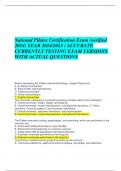National Pilates Certification Exam (verified
2024) YEAR 2024/2025 / ACCURATE
CURRENTLY TESTING EXAM VERSIONS
WITH ACTUAL QUESTIONS
Before developing the Pilates method/Contrology, Joseph Pilates was
A: A. Dancer and director.
B. Stock broker and businessman.
C. Pugilist and acrobat.
D. Doctor and professor.
C. Pugilist and acrobat.
The information obtained in a postural screening includes which of the following?
A. Overall symmetry, height, weight, and balance.
B. Overall symmetry, muscle development, and alignment deviations. C. Pelvic
symmetry, muscular patterns, and movement deviations.
D. Overall symmetry, alignment deviations, and proprioception.
B. Overall symmetry, muscle development, and alignment deviations.
Read More
The Pilates exercises rocking, grasshopper, and swimming, which are performed on the
reformer, are:
A. Performed holding the straps or rope handles.
B. Performed at the beginning of a reformer workout.
C. Easily performed by participants with spinal stenosis.
D. Extension exercises performed on the long box.
D. Extension exercises performed on the long box.
The primary muscles/muscle groups that make up the core are:
A. Transverse abdominis, abdominal external oblique, iliocostalis, and adductors.
,B. Hamstrings, rectus abdominis, abdominal internal oblique, and tensor fascia latae.
C. Diaphragm, transverse abdominus, multifidus, and pelvic floor.
D. Transverse abdominis, gluteus maximus, multifidus, and pelvic floor.
C. Diaphragm, transverse abdominus, multifidus, and pelvic floor.
An example of assisted retraction and resisted protraction on the Pilates apparatus is:
A. Pulling straps on the reformer.
B. Swan from floor on the low chair.
C. Swan on the ladder barrel.
D. Swan on the low chair.
D. Swan on the low chair.
Which of the following describes the muscular contraction in which the muscle shortens
to produce force and accelerate movement?
A. Concentric.
B. Isometric.
C. Eccentric.
D. Isotonic.
A. Concentric.
Identify which of the following ARE within the scope of practice for a Pilates teacher.
a. Prescribing an exercise program
b. Design Pilates exercise programs according to an individual's needs
c. Prescribing diets or recommending supplements.
d.Diagnosing a client with any medical, mental or physical condition.
b. Design Pilates exercise programs according to an individual's needs
Identify which of the following ARE NOT within the scope of practice for a Pilates
teacher.
a. Promote exercise to improve overall health
b. Coach, provide general information and direct clients to seek medical attention.
c. Offering counseling.
d. Recognize conditions that would preclude a client from safely participating in a
Pilates exercise program.
c. Offering counseling.
What are the 13 Code of Ethics?
1. Do no harm.
2. Teach within the scope of practice.
3. Maintain professional boundaries.
4. Maintain client confidentiality.
5. Direct clients to seek medical attention when necessarily.
6. Do not discriminate against clients or colleagues on any level.
7. Do not intentionally solicit other Pilates professionals's clients.
8. Treat clients and colleagues with respect, truth, fairness, and integrity.
9. Comply with all applicable business, employment and intellectual property laws.
10. Maintain professional appearance and conduct.
11. Do not misrepresent skills, training, professional credentials, identity or services
12. Continue gaining education to enhance skills and knowledge.
13. Maintain appropriate teacher-to-student ratios in all class settings.
What are the continuing education requirements for certificates?
, Certificants must earn 16 NPCP-approved CECs in order to renew their certification.
How often must certificates complete their CECs?
All CECs must be completed within a two (2) year renewal period.
True or False. The NCPC may refuse to certify, suspend, or revoke an existing
certification, or otherwise take action with regard to the application or certification of an
individual.
True
Client documentation
Best business practices
Professional boundaries
client communication
self-care
personal conduct and presentation
Basic movement sciences
What are three planes of movement?
Sagittal: left and right
Frontal: anterior and posterior
Transverse: superior and inferior
Accommodations for common health conditions and anatomical variations
What are contradictions for a client who presents with Facet Joint Syndrome?
Avoid extension of the spine
* May be painful to combine extension, rotation and side-bending
What are contradictions for a client who presents with Herniated Nucleus Pulpous?
- In acute stage/symptomatic: avoid spinal flexion or vertical loading of the spine
* Avoid any exercise that involves a straight leg raise or strong spinal rotation
What are contradictions for a client who presents with Spondylolisthesis?
- Avoid extension of the spine in the segment where the instability is occuring
What are contradictions for a client who presents with Stenosis?
Avoid extension of the stenotic segment of the spine
What are contradictions for a client who presents with Total Hip Replacement?
- Anterior Approach: precautions may depend on physician
- Posterior Approach: hip flexion above 90, internal rotation, hip adduction
What precautions should be taken for a client who presents with Adhesive Capsulitis?
Avoid aggressive stretching and end-range loading of the shoulder joint
What precautions should be taken for a client who presents with Carpal Tunnel
Syndrome?
Avoid resistance training of the upper body, wrist flexion, forearm supination and
pressure at the base of the palm
What precautions should be taken for a client who presents with Plantar fascitis?
Avoid any weight bearing exercise that causes in increase in heel or arch pain or
shortens the calf muscles
What precautions should be taken for a client who presents with Rotator Cuff
Impingement?
- Avoid overhead shoulder positions that cause pain
- Avoid internal rotation or end-range loading of the joint combined with abduction




